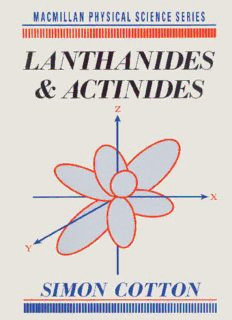Table Of ContentLanthanides and actinides
MACMILLAN PHYSICAL SCIENCE
Series advisers
Physics titles: Dr R L Havill, University of Sheffield
Dr A K Walton, University of Sheffield
Chemistry titles: Dr D M Adams, University of Leicester
Dr M Green, University of York
Titles in the series
Group Theory for Chemists, G Davidson
Thermal Physics, M T Sprackling
Lower Temperature Physics, A Kent
MACMILLAN PHYSICAL SCIENCE SERIES
Lanthanides
and actinides
Simon Cotton
Felixsfowe College
M
MACMILLAN
EDUCATION
© Simon Cotton 1991
Softcover reprint of the hardcover 1s t edition 1991
All rights reserved. No reproduction, copy or transmission
of this publication may be made without written permission.
No paragraph of this publication may be reproduced, copied
or transmitted save with written permission or in accordance
with the provisions of the Copyright, Designs and Patents Act
1988 or under the terms of any licence permitting limited
copying issued by the Copyright Licensing Agency,
33-4 Alfred Place, London WCIE 7DP.
Any person who does any unauthorised act in relation to
this publication may be liable to criminal prosecution and
civil claims for damages.
First edition 1991
Published by
MACMILLAN EDUCATION LTD
Houndmills, Basingstoke, Hampshire RG21 2XS
and London
Companies and representatives
throughout the world
British Library Cataloguing in Publication Data
Cotton, Simon
Lanthanides & actinides
1. Rare earth elements & actinide elements
I. Title
546.41
ISBN 978-1-349-11906-6 ISBN 978-1-349-11904-2 (eBook)
DOI 10.1007/978-1-349-11904-2
To my mother andfather
Contents
Preface ix
Acknowledgements x
Chapter 1 Scandium 1
1.1 Introduction 1
1.2 Binary compounds of scandium 3
1.3 Complexes of scandium 5
1.4 Organometallic compounds of scandium 7
Chapter 2 The lanthanides 10
2.1 Position of the lanthanides in the Periodic Table 10
2.2 Ores: separation and processing 15
2.3 The metals and their alloys 17
2.4 Characteristics of the lanthanides 20
2.5 Stability of lanthanide oxidation states 21
2.6 Spectroscopic and magnetic properties of the
lanthanides 27
2.7 Physical methods for investigating lanthanide
complexes 34
2.8 Lanthanide binary compounds 41
2.9 Stability constants of lanthanide complexes 49
2.10 Coordination compounds 52
2.11 Some applications of lanthanides in NMR 66
2.12 Unusual oxidation states 70
2.13 Promethium 75
2.14 Organometallic chemistry 76
Chapter 3 The actinides 85
3.1 Position in the Periodic Table 85
3.2 Synthesis of the actinides 85
viii Lanthanides and adinides
3.3 Oxidation states and electron configurations 88
3.4 Characteristics of the actinides 91
3.5 Extraction of the metals 92
3.6 Isotope separation methods 94
3.7 Toxicity of the actinides 95
3.8 Nuclear waste processing and disposal 96
3.9 Some problems encountered in studying the
actinides - and some solutions 99
3.10 Systematics and trends in the actinide halides 100
3.11 Magnetic and spectroscopic properties 107
3.12 Chemistry of the elements - actinium 114
3.13 Chemistry of the elements - thorium 115
3.14 Chemistry of the elements - protactinium 121
3.15 Chemistry of the elements - uranium 125
3.16 Chemistry of the elements - neptunium 143
3.17 Chemistry of the elements - plutonium 146
3.18 Chemistry of the elements - americium 152
3.19 Chemistry of the actinides beyond americium 156
3.20 Some applications of the actinides 159
3.21 Actinide organometallic chemistry 160
3.22 Synthesis and properties of elements 104-109 167
3.23 Superheavy elements? 168
Appendix A: Ionisation energies of lanthanides and actinides 170
Appendix B: Ionic radii of lanthanides and actinides 171
Appendix C: Periodic Table 172
Bibliography 173
Index 183
Preface
This book is intended to provide an adequate background to the chemistry
of the f-block metals for students on advanced undergraduate courses, as
well as for postgraduates. It is hoped that it will also be of value to teachers
requiring an up-to-date account of the descriptive chemistry of these
metals.
All books reflect the interests (and prejudices) of their authors; this one
is no exception in that it concentrates its efforts in attempting to give a
sound factual foundation, relying on the Bibliography (at the end of the
book) to give the reader access to a wider spectrum of the literature.
It is a very real pleasure to thank many people for their contributions to
this book:
Drs D M Adams and M Green, for helpful comments on the manuscript;
members of the secretarial staff of Stanground College - Jane, Sue,
Anne, and all 'the girls' for their help with the production of parts of the
manuscript, especially some awkward tables; Kerry Lawrence and her
colleagues at Macmillan Education for their tolerance; and the Chemis
try Department of Cambridge University for library facilities.
I would wish to single out Dr Alan Hart, without whose collaboration,
advice and influence I would never have been in a position to undertake
this book; Dom Philibert Zobel and the monastic community of Bec for the
hospitality of their roof while I compiled the Index and Bibliography; and
last, but by no means least, Carolyn Wright who uncomplainingly trans
lated my writing into typescript.
Simon Cotton
Abbaye N. D. du Bee
Feast of the Transfiguration
1990
IX
Acknowledgements
The author and publishers wish to thank the following who have kindly
given permission for the use of copyright material:
The American Chemical Society for Figures 1.1,2.13,2.14,2.27,3.15
and 3.41;
The Editor of the Journal of Chemical Education for Figure 2.2;
Dr S. Hufner and Kluwer Academic Publishers for Figure 2.9;
Pergamon Press PLC for Figures 2.14(b), 3.7 and 3.13;
The Royal Society of Chemistry for Figures 2.17, 2.21, 2.33, 2.38 and
3.28;
Elsevier Scientific Publications for Figure 3.9;
The Editor of Inorganica Chimica Acta for Figures 3.14,3.16 and 3.17.
Every effort has been made to trace all the copyright holders but if any
have been inadvertently overlooked the publisher will be pleased to make
the necessary arrangement at the first opportunity.

